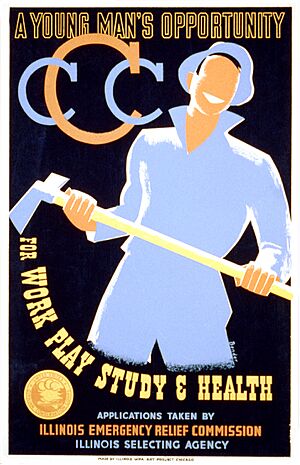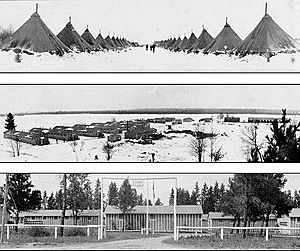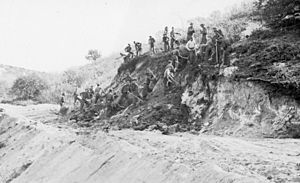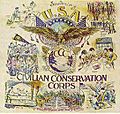Civilian Conservation Corps facts for kids
The Civilian Conservation Corps (CCC) was a special government program in the United States that ran from 1933 to 1942. It was created to help young men who didn't have jobs during a tough time called the Great Depression in the United States. The CCC was a big part of President Franklin D. Roosevelt's plan, known as the New Deal.
The program gave jobs to young men, usually between 18 and 25 years old, though later it included those from 17 to 28. These jobs involved working outdoors to protect and improve America's natural resources. They worked on lands owned by the government, both federal and state, and local areas. The CCC helped these young men and their families, who were struggling to find work.
At its busiest, the CCC had 300,000 young men working at one time. Over nine years, about 3 million young men joined the program. They received a place to live, clothes, and food. They also got a small wage of $30 a month, but $25 of that had to be sent home to their families to help them out.

The CCC was very popular with the American public. People at the time said that joining the CCC helped young men become healthier, feel better about themselves, and have a better chance of finding future jobs. The program also made people care more about nature and understand how important it was to protect and develop the country's natural areas.
During the CCC's time, its workers planted almost 3 billion trees to help regrow forests across America. They built trails, lodges, and other buildings in over 800 parks nationwide. They also improved most state parks, found better ways to fight forest fires, and built roads and service buildings in faraway places.
The CCC also had separate programs for military veterans and Native Americans. About 15,000 Native Americans took part, which helped them get through the Great Depression.
Even though it was very popular, the CCC was not meant to last forever. It relied on special, temporary laws and funding from Congress. By 1942, when World War II began and many young men were joining the military, there wasn't as much need for the CCC. So, Congress decided to end the program.
Contents
What Kind of Work Did the CCC Do?

The CCC worked on about 300 different types of projects, which were grouped into ten main categories:
- Building Things: They built bridges, fire lookout towers, and other useful buildings.
- Transportation: They created truck trails, smaller roads, foot trails, and even landing fields for airplanes.
- Stopping Erosion: They built small dams (check dams), created terraces on hillsides, and planted plants to stop soil from washing away.
- Controlling Floods: This included setting up irrigation systems, drainage, building dams, digging ditches, and strengthening riverbanks with rocks (riprapping).
- Forest Care: They planted trees and shrubs, improved timber stands, collected seeds, and worked in plant nurseries.
- Forest Protection: They focused on preventing and fighting forest fires, and controlling harmful insects and diseases.
- Parks and Fun Areas: They developed public campgrounds and picnic spots, and cleared and improved lake and pond areas.
- Rangeland Care: They created paths for livestock and helped control animals that harmed other wildlife.
- Wildlife Protection: They improved streams for fish, stocked fish in lakes, and planted food and cover for animals.
- Other Projects: This included emergency work, surveys, and controlling mosquitoes.
Remembering the CCC
Many places today have museums or memorials to honor the work of the Civilian Conservation Corps. These museums help people learn about the important projects the CCC completed and the impact it had on the country.
CCC Museums You Can Visit
- Civilian Conservation Corps Museum, Vogel State Park, Blairsville, Georgia
- Colossal Cave Mountain Park, Vail, Arizona
- Conservation Corps State Museum at Camp San Luis Obispo, San Luis Obispo, California
- Civillan Conservation Corps Museum, Rhinelander, Wisconsin
- Florida Civilian Conservation Corps Museum at Highlands Hammock State Park, Sebring, Florida
- Civilian Conservation Corps Museum at DeSoto State Park, Fort Payne, Alabama
- Civilian Conservation Corps Camp in Koke'e State Park, Waimea, Kauai County, Hawaii
- Iowa Civilian Conservation Corps Museum at Backbone State Park, Strawberry Point, Iowa
- Civilian Conservation Corps Museum at Lake Greenwood State Recreation Area, Ninety Six, South Carolina
- Lou and Helen Adams Civilian Conservation Corps Museum, Parker Dam State Park, Huston Township, Clearfield County, Pennsylvania.
- Masker Museum at Promised Land State Park, Greentown, Pennsylvania
- New York State Civilian Conservation Corps Museum at Gilbert Lake State Park, New Lisbon, New York
- Civilian Conservation Corps Museum at Pocahontas State Park, Chesterfield, Virginia
- Civilian Conservation Corps Museum, Guernsey State Park, Guernsey, Wyoming
- Bear Brook State Park Civilian Conservation Corps (CCC) Camp Historic District, Allenstown, New Hampshire
The CCC's Lasting Impact
Even though the original CCC program ended, its ideas lived on. It became a model for other conservation programs that started after World War II. Today, there are many similar programs across the country, run by national, state, and local groups. These modern programs still involve young people (usually ages 16–25) in community service, training, and education. In 2004, about 113 such programs were active in 41 states, helping over 23,000 young people.
Images for kids
-
A CCC pillowcase on display at the CCC Museum in Michigan
-
Statue of CCC worker in Santa Fe, New Mexico
-
In Phalen Park, St. Paul Minnesota, the workers constructed a monument to commemorate their work on this site.
-
Statue of CCC worker in Freetown-Fall River State Forest Freetown, Massachusetts
See also
 In Spanish: Cuerpo Civil de Conservación para niños
In Spanish: Cuerpo Civil de Conservación para niños









